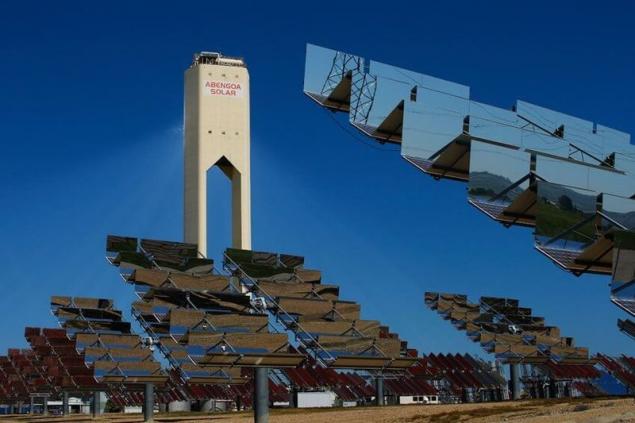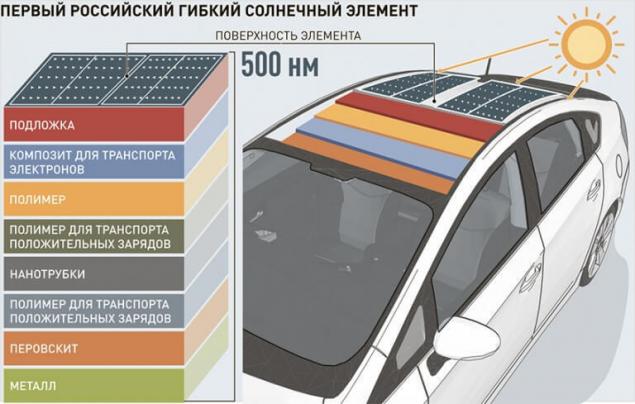Battery please the sun
 Bashny.Net
Bashny.Net
Fundamentally new solar cell, developed in the laboratory of the nust MISIS under the supervision of the visiting Professor from the University of Texas Anvar Zakhidov, will cost three times cheaper than the best analogues of silicon. And with mass production the difference will be 4-6-fold. It promises a real breakthrough in solar energy.
However, today it is booming, but plans grandiose. So, Europe intends by 2020 to bring the contribution of the Sun in total energy consumption to 25 percent, and by 2040, 40 percent. Not less ambitious plans in the U.S.: by 2020 the contribution of solar electricity in the country should be 25 percent.
In short, the leading countries rely on the Sun. However, with one caveat: while it needs serious backup state. She provided the most favorable conditions for intensive development.

However, the high price in comparison with traditional sources of energy is not the only disadvantage of solar watt. Getting silicon, which is used to produce solar panels, creates a lot of problems. It is toxic, expensive, requires a lot of energy. Moreover, such battery is inconvenient to use: they are rigid, heavy and fragile to install necessary special gadgets. In short, with them a lot of trouble. It is quite another thing — the battery is flexible. It can roll like a roll on any curved surface. That immediately expands the scope of application. Such solar cells for the first time in Russia created by scientists and engineers Misa.
— In them there is silicon, which allowed to give the battery the necessary flexibility, explains the laboratory of Daniel Saranin. Is the combination of a material called perovskite, and the semiconductor polymers. In contrast to the expensive silicon perovskite worth a penny. But the main advantage of such a tandem is not even that. The technology of making batteries out of silicon is very complicated, it requires high vacuum and expensive equipment. And our method is much simpler and cheaper. In fact, solar cells can be printed on simple devices.

Start the perovskite electronics gave the Japanese, who created the first solar tandem with an efficiency of 3.9 percent. In the world immediately assessed the prospects in the race involved many leading foreign laboratories, and now the efficiency has already reached 21.3 percent. But if for silicon this figure is almost close to the limit of its possibilities, to overcome which do not allow the laws of physics, the solar tandem capable of more. The fact that the silicon collects only a small portion of the visible solar spectrum, a tandem almost the entire. Here are the growth prospects.
— In addition, we intend to further increase efficiency at the expense of its other know-how, says Saranin. — If very simple, the essence in the following. Our element consists of eight layers, that is similar to a sandwich. Why so much? The light immediately transformed into an electric current, for this it is required to pass several cascades of transformations. So our competitors are linking all these layers in series, plus to minus. We proposed another option — to connect in parallel, plus to plus, minus to minus. As shown by experiments, this can significantly raise efficiency.
Now scientists are testing the obtained solar cell, and next year intend to begin commercial testing. published
P. S. And remember, only by changing their consumption — together we change the world! ©
Join us in Facebook , Vkontakte, Odnoklassniki
Source: altenergiya.ru/sun/batarei-prosyat-solnca.html
However, today it is booming, but plans grandiose. So, Europe intends by 2020 to bring the contribution of the Sun in total energy consumption to 25 percent, and by 2040, 40 percent. Not less ambitious plans in the U.S.: by 2020 the contribution of solar electricity in the country should be 25 percent.
In short, the leading countries rely on the Sun. However, with one caveat: while it needs serious backup state. She provided the most favorable conditions for intensive development.

However, the high price in comparison with traditional sources of energy is not the only disadvantage of solar watt. Getting silicon, which is used to produce solar panels, creates a lot of problems. It is toxic, expensive, requires a lot of energy. Moreover, such battery is inconvenient to use: they are rigid, heavy and fragile to install necessary special gadgets. In short, with them a lot of trouble. It is quite another thing — the battery is flexible. It can roll like a roll on any curved surface. That immediately expands the scope of application. Such solar cells for the first time in Russia created by scientists and engineers Misa.
— In them there is silicon, which allowed to give the battery the necessary flexibility, explains the laboratory of Daniel Saranin. Is the combination of a material called perovskite, and the semiconductor polymers. In contrast to the expensive silicon perovskite worth a penny. But the main advantage of such a tandem is not even that. The technology of making batteries out of silicon is very complicated, it requires high vacuum and expensive equipment. And our method is much simpler and cheaper. In fact, solar cells can be printed on simple devices.

Start the perovskite electronics gave the Japanese, who created the first solar tandem with an efficiency of 3.9 percent. In the world immediately assessed the prospects in the race involved many leading foreign laboratories, and now the efficiency has already reached 21.3 percent. But if for silicon this figure is almost close to the limit of its possibilities, to overcome which do not allow the laws of physics, the solar tandem capable of more. The fact that the silicon collects only a small portion of the visible solar spectrum, a tandem almost the entire. Here are the growth prospects.
— In addition, we intend to further increase efficiency at the expense of its other know-how, says Saranin. — If very simple, the essence in the following. Our element consists of eight layers, that is similar to a sandwich. Why so much? The light immediately transformed into an electric current, for this it is required to pass several cascades of transformations. So our competitors are linking all these layers in series, plus to minus. We proposed another option — to connect in parallel, plus to plus, minus to minus. As shown by experiments, this can significantly raise efficiency.
Now scientists are testing the obtained solar cell, and next year intend to begin commercial testing. published
P. S. And remember, only by changing their consumption — together we change the world! ©
Join us in Facebook , Vkontakte, Odnoklassniki
Source: altenergiya.ru/sun/batarei-prosyat-solnca.html
Tags
See also
Solar panels based on iron
Solar panels for Saratov SES will be made in Russia
How much are solar panels
Fuel cell technology, Bloom Energy is changing the approach to clean energy production
Began testing hybrid power plant of concentrated solar power
Hydrogen energy in Yakutia has more potential than solar
Luxury residential complex with the function of the power plant will be built on the Caribbean
Alternative energy in Yakutia
Clean energy from roads in Canada
Floating Islands of solar panels

















